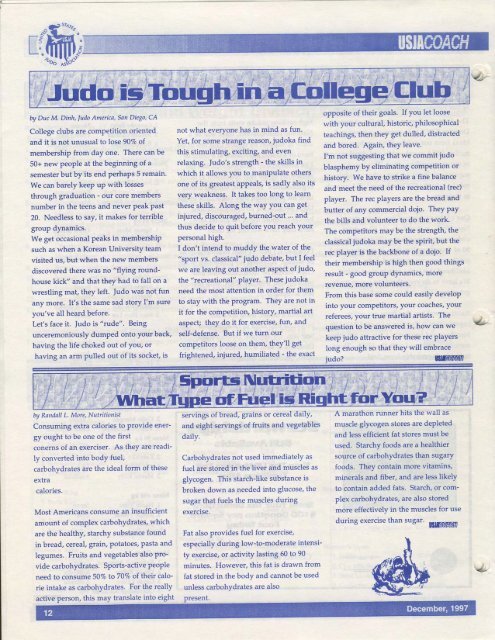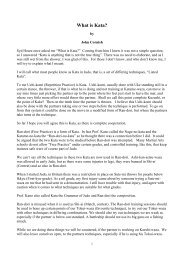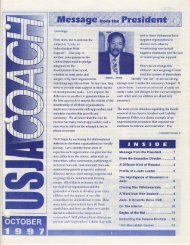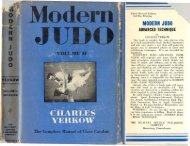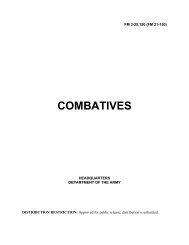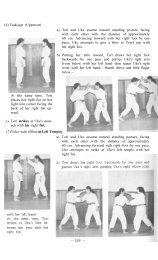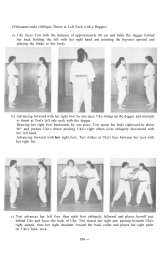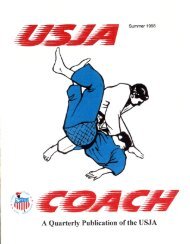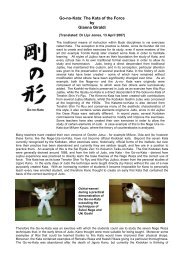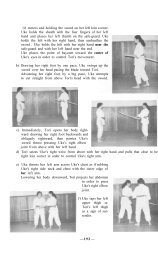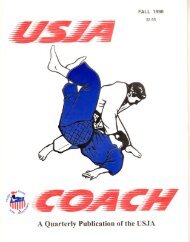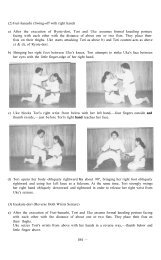USJA Coach - Judo Information Site
USJA Coach - Judo Information Site
USJA Coach - Judo Information Site
- No tags were found...
You also want an ePaper? Increase the reach of your titles
YUMPU automatically turns print PDFs into web optimized ePapers that Google loves.
z nl<br />
^9<br />
by Duc M. Dinh,ludo America, San Diego, CA<br />
College clubs are competition oriented<br />
and it is not unusual to lose 90Vo of<br />
membership from day one. There can be<br />
50+ new people at the beginning of a<br />
semester but by its end perhaps 5 remain'<br />
We can barely keep up with losses<br />
through graduation - our core members<br />
number in the teens and never peak past<br />
20. Needless to say, it makes for terrible<br />
group dynamics.<br />
We get occasional peaks in membership<br />
such as when a Korean University team<br />
visited us, but when the new members<br />
discovered there was no "flying roundhouse<br />
kick" and that they had to fall on a<br />
wrestling mat, they left. <strong>Judo</strong> was not fun<br />
any more. It's the same sad story I'm sure<br />
you've all heard before.<br />
Let's face it. <strong>Judo</strong> is "rude". Being<br />
unceremoniously dumped onto your back,<br />
having the life choked out of You, or<br />
having an arm pulled out of its socket, is<br />
not what everyone has in mind as fun.<br />
Yet, for some strange reason, judoka find<br />
this stimulating, exciting, and even<br />
relaxing. judo's strength - the skills in<br />
which it allows you to manipulate others<br />
one of its greatest appeals, is sadly also its<br />
very weakness. It takes too long to learn<br />
these skills. Along the way you can get<br />
injured, discouraged, burned-out ... and<br />
thus decide to quit before you reach your<br />
personal high.<br />
I don't intend to muddy the water of the<br />
"sport vs. classical" judo debate, but I feel<br />
we are leaving out another aspect of judo,<br />
the "recreational" player. These judoka<br />
need the most attention in order for them<br />
to stay with the Program. They are not in<br />
it for the competition, history, martial art<br />
aspect; they do it for exercise, fun, and<br />
self-defense. But if we turn our<br />
competitors loose on them, they'll get<br />
frightened, injured, humiliated - the exact<br />
opposite of their goals. If you let loose<br />
with your cultural, historic, philosophical<br />
teachings, then they get dulled, distracted<br />
and bored. Again, theY leave.<br />
I'm not suggesting that we commit judo<br />
blasphemy by eliminating comPetition or<br />
history. We have to strike a fine balance<br />
and meet the need of the recreational (rec)<br />
player. The rec players are the bread and<br />
butter of any commercial dojo' They pay<br />
the bills and volunteer to do the work-<br />
The competitors may be the strength, the<br />
classical judoka may be the spirit, but the<br />
rec player is the backbone of a dojo. If<br />
their membership is high then good things<br />
result - good group dynamics, more<br />
revenue, more volunteers.<br />
From this base some could easily develop<br />
into your competitors, your coaches, your<br />
referees, your true martial artists. The<br />
question to be answer"i ,r, no* can we<br />
keep judo attractive for these rec players<br />
long enough so that they will embrace<br />
judo<br />
NreGreH<br />
L'<br />
by Randall L. More, Nutritionist<br />
Consuming extra calories to provide energy<br />
ought to be one of the first<br />
conerns of an exerciser. As they are readily<br />
converted into body fuel,<br />
carbohydrates are the ideal form of these<br />
extra<br />
calories.<br />
Most Americans consume an insufficient<br />
amount of complex carbohydrates, which<br />
are the healthy, starchy substance found<br />
in bread, cereal, grain, potatoes, pasta and<br />
legumes. Fruits and vegetables also Provide<br />
carbohydrates. Sports-active people<br />
need to consume 50Vo to 70Vo of their calorie<br />
intake as carbohydrates. For the really<br />
active person, this may translate into eight<br />
servings of bread, grains or cereal daily,<br />
and eight servings of fruits and vegetables<br />
daily.<br />
Carbohydrates not used immediately as<br />
fuel are stored in the liver and muscles as<br />
glycogen. This starch-like substance is<br />
broken down as needed into glucose, the<br />
sugar that fuels the muscles during<br />
exercise.<br />
Fat also provides fuel for exercise,<br />
especially during low-to-moderate intensity<br />
exercise, or activity lasting 60 to 90<br />
minutes. However, this fat is drawn from<br />
fat stored in the body and cannot be used<br />
unless carbohydrates are also<br />
present.<br />
A marathon runner hits the wall as<br />
muscle glycogen stores are depleted<br />
and less efficient fat stores must be<br />
used. Starchy foods are a healthier<br />
source of carbohydrates than sugary<br />
foods. They contain more vitamins,<br />
minerals and fiber, and are less likely<br />
to contain added fats. Starch, or complex<br />
carbohydrates, are also stored<br />
more effectively in the muscles for use<br />
during exercise than sugar. HrereE**<br />
4,


